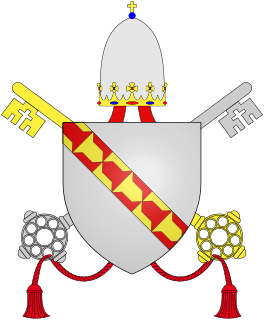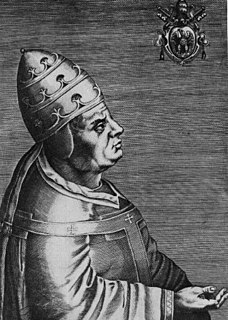Pierre de la Vergne, aka Pierre de Veruche, Pierre Verneyo, Pierre Veruco, Pierre Verrujo or Pierre Veroche, Latin Petrus de Vernio (died 6 October 1403 in Avignon was a French cardinal.
Contents

Pierre de la Vergne, aka Pierre de Veruche, Pierre Verneyo, Pierre Veruco, Pierre Verrujo or Pierre Veroche, Latin Petrus de Vernio (died 6 October 1403 in Avignon was a French cardinal.

Pierre de la Vergne studied Canon law at the University of Montpellier. [1] He was a disciple of Johannes Klenkok and was appointed cardinal deacon by Pope Gregory XI in 1371 taking the titular church Santa Maria in Via Lata. [2]
During the conflict about the Sachsenspiegel law book he handed the Decadicon - a written attack by Johannes Klenkok on the Sachsenspiegel - to Pope Gregory XI. Gregory considered the attack and later issued the papal bull Salvator humani generis condemning 14 articles of the Sachsenspiegel on 8 April 1374. [3]
De la Vergne participated in the papal conclave 1378 during which Pope Urban VI was elected [4] and later in 1378 in the papal conclave that elected Antipope Clement VII. [5] In 1379 he joined the Roman Obedience together with the other French cardinals.

Pope Martin IV, born Simon de Brion, was the head of the Catholic Church and ruler of the Papal States from 22 February 1281 to his death. He was the last French pope to have held court in Rome; all subsequent French popes held court in Avignon.

Pope Gregory XI was head of the Catholic Church from 30 December 1370 to his death in 1378. He was the seventh and last Avignon pope and the most recent French pope recognized by the modern Catholic Church. In 1377, Gregory XI returned the Papal court to Rome, ending nearly 70 years of papal residency in Avignon, France. His death shortly after was followed by the Western Schism involving two Avignon-based antipopes.

The Avignon Papacy was the period from 1309 to 1376 during which seven successive popes resided in Avignon rather than in Rome. The situation arose from the conflict between the papacy and the French crown, culminating in the death of Pope Boniface VIII after his arrest and maltreatment by Philip IV of France. Following the further death of Pope Benedict XI, Philip forced a deadlocked conclave to elect the French Clement V as pope in 1305. Clement refused to move to Rome, and in 1309 he moved his court to the papal enclave at Avignon, where it remained for the next 67 years. This absence from Rome is sometimes referred to as the "Babylonian captivity of the Papacy".

The Western Schism, also known as the Papal Schism, the Vatican Standoff, the Great Occidental Schism, or the Schism of 1378, was a split within the Catholic Church lasting from 1378 to 1417 in which bishops residing in Rome and Avignon both claimed to be the true pope, and were joined by a third line of Pisan claimants in 1409. The schism was driven by personalities and political allegiances, with the Avignon papacy being closely associated with the French monarchy. These rival claims to the papal throne damaged the prestige of the office.

Guy de Malsec was a French bishop and cardinal. He was born at the family's fief at Malsec (Maillesec), in the diocese of Tulle. He had two sisters, Berauda and Agnes, who both became nuns at the Monastery of Pruliano (Pruilly) in the diocese of Carcassonne, and two nieces Heliota and Florence, who became nuns at the Monastery of S. Prassede in Avignon. He was a nephew of Pope Gregory XI, or perhaps a more distant relative. He was also a nephew of Pope Innocent VI. Guy was baptized in the church of S. Privatus, some 30 km southeast of Tulle. He played a part in the election of Benedict XIII of the Avignon Obedience in 1394, in his status as second most senior cardinal. He played an even more prominent role in Benedict's repudiation and deposition. Guy de Malsec was sometimes referred to as the 'Cardinal of Poitiers' (Pictavensis) or the 'Cardinal of Palestrina' (Penestrinus).

Jean de Murat du Cros was a French cardinal of the Catholic Church. He became the Bishop of Limoges (1347–1371). He was a leader in what became the Great Schism within Western Christianity.

The Roman Catholic Diocese of Valence (–Die–Saint-Paul-Trois-Châteaux) (Latin: Dioecesis Valentinensis ; French: Diocèse de Valence is a diocese of the Latin Church of the Roman Catholic Church in southern France. The contemporary diocese is co-extensive with the department of Drôme.

Jean Cholet was a French cardinal and Doctor utriusque iure at the University of Paris. His diplomatic skills helped prevent a duel between the kings of France and Aragon. He served as Papal Legate in France, and was responsible for organizing the Aragonese Crusade of 1283–84. He was then a working member of the Roman Curia.

The 1342 papal conclave – the papal conclave convened after the death of Pope Benedict XII, it elected Cardinal Pierre Roger, who became the fourth Pope of the period of Avignon Papacy under the name Clement VI.

Pierre Desprès (1288–1361) was a French Cardinal during the period of the Avignon Papacy.

The 1370 papal conclave, held after the death of Pope Urban V, elected as his successor Cardinal Pierre Roger de Beaufort, who under the name Gregory XI became seventh and the last pope of the period of Avignon Papacy.

Jean Lemoine, Jean Le Moine, Johannes Monachus was a French canon lawyer, Cardinal, bishop of Arras and papal legate. He served Boniface VIII as representative to Philip IV of France, and founded the Collège du Cardinal Lemoine, in Paris. He is the first canon lawyer to formulate the legal principle of the presumption of innocence.

Anglic de Grimoard, also recorded as Angelic, was a French canon regular and a Cardinal. He was the younger brother of Pope Urban V.

The 1378 papal conclave which was held from April 7 to 9, 1378, was the papal conclave which was the immediate cause of the Western Schism in the Catholic Church. The conclave was one of the shortest in the history of the Catholic Church. The conclave was also the first since 1159 held in the Vatican and in Old St. Peter's Basilica.

Bertrand du Pouget was a French papal diplomat and Cardinal.

Pierre de Murat de Cros, O.S.B., was a French monk of aristocratic origins who became a cardinal of the Avignon Obedience during the Great Schism, as well as the Archbishop of Arles and the Chamberlain of the Apostolic Camera. Refusing from the day of his election to support Bartolomeo Prignano after the Papal Conclave of 1378, de Cros played a critical role in delivering a considerable portion of the Roman Curia to the rival claimant Robert of Geneva, who took the name Clement VII. Historian Daniel Williman calls Murat de Cros's actions a "counter-coup".
Nicolas de Nonancourt. He was a French university Chancellor, Dean of a Cathedral, and Roman Catholic Cardinal.

Raymond de Canillac was a French lawyer, bishop, and cardinal. He was born at Roche de Canilhac, the family castle, in the diocese of Mende in the Gevaudan in central France, the son of Guillaume de Canillac and a sister of Cardinal Bertrand de Déaulx. Both of his uncles, Pons and Guy, were successively abbots of Aniane, as was a nephew of the Cardinal, also called Pons. In 1345 his niece Garine, the daughter of his brother Marquis and of Alixène de Poitiers-Valentinois, married Guillaume Roger, Vicount of Beaufort, the brother of Cardinal Pierre Roger de Beaufort, who became Pope Clement VI. Raymond became a member of the Canons Regular of Saint Augustine (CRSA). He studied law at the University of Montpellier, and obtained the degree of Doctor in utroque iure.

Pierre Girard was born in the commune of Saint-Symphorien-sur-Coise, in the Department of Rhone, once in the ancient County of Forez. He died in Avignon on 9 November 1415. He was Bishop of Lodeve and then Bishop of Le Puy. He was a cardinal of the Avignon Obedience during the Great Western Schism, and was promoted to the Bishopric of Tusculum (Frascati). His principal work, however, was as a courtier and administrator at Avignon, and as a papal diplomat.

Rolandus was a cardinal of the Roman Catholic Church. He was a native of Pisa, not Siena or Brittany. He was elected archbishop of Dol, but was not consecrated for five years, due to the opposition his metropolitan, the archbishop of Tours. Before he became a cardinal, he was sent by Pope Lucius III as his representative to Scotland to attempt to resolve a dispute over episcopal elections, involving the king.